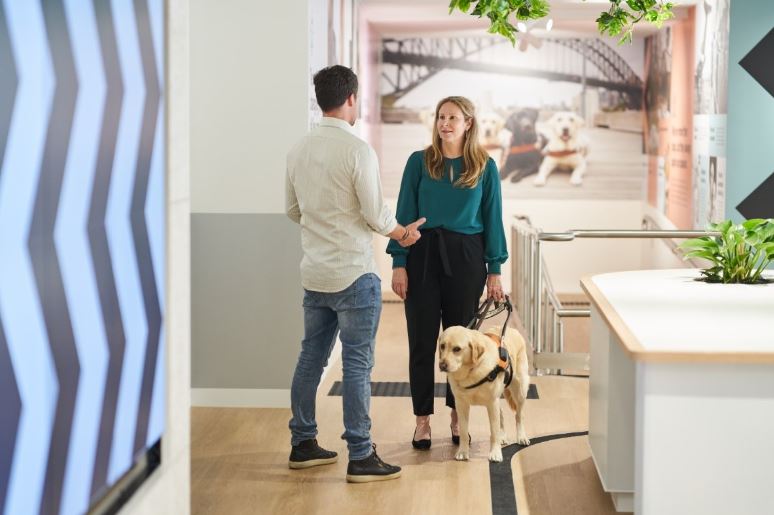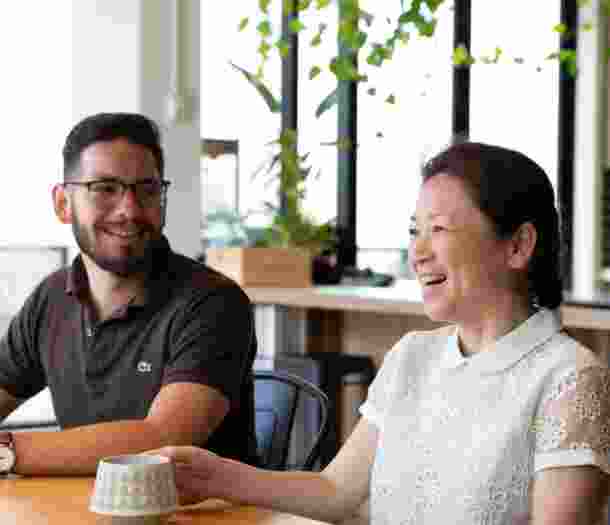Interacting with a person with blindness or low vision
The techniques on this page will ensure effective, safe and inclusive interactions with a person with blindness or low vision. Remember, not every person with blindness or low vision will need assistance.
- Always introduce yourself, even if you know the person.
- Address the person directly and never through a third person such as a spouse or carer.
- If you are planning to assist the person, say beforehand what actions you will be performing. For example, “Hi Rosie, it’s Stella from Guide Dogs. Can I guide you to your chair?”
- Announce when you are leaving the room or the conversation.
Offering assistance to someone with blindness or low vision

Sometimes well-meaning members of the public try to help people who are blind or have low vision without warning, which can be stressful.
If you think a person who is blind or has low vision needs assistance, confirm by introducing yourself and asking: “can I help you?”
Here are the simple steps for offering support to a person who is blind or has low vision.
- Approach: Approach the person. Identify who you are including your name, even if you’ve met the person before.
- Ask: “Would you like any assistance?” or “Do you need a hand?”
- Assist: If your offer is accepted, you might provide guiding support, give directions, describe the space or provide other helpful information.
Guiding a person with blindness or low vision

People with low vision and blindness sometimes require assistance to move through an area. The aim of providing guidance is to support a person so they can travel safely, confidently and efficiently.
If you think a person who is blind or has low vision might need guiding assistance, just introduce yourself and ask. If they would like to be guided:
- Ask which side they would prefer you to be on and whether they would like to hold your arm.
- If the person would like to take your arm, touch the back of your hand to the back of the person’s hand.
- Confirm the person is ready to go.
- Start walking, maintaining a natural pace.
Good communication is the key to being a good guide. If you’re ever unsure about anything, just ask.
Assisting with orientation
Sometimes a person who is blind or has low vision may appreciate support to move around a space independently, understand the layout of a room or space and know who’s there or get to where they want to go.
Providing directions
If a person who is blind or has low vision needs directions, give them clear and precise directions from where they are located.
Don’t use vague descriptions such as “over there” or gesture by pointing. Instead, use indicators such as right or left. Stand in the same direction as the person you are assisting so that your left is the same as their left. For example, “the bathroom is located about 5 metres to your left”.
You could also use the clock face method, giving directions from the point of view of the person facing 12 o’clock. Directions are then described relative to their location on the clock-face, e.g. “Your drink is at two o’clock on the table”.
Understanding the layout of a space
People who are blind or have low vision may be unable to see the layout and contents of a room, so ask if you can help.
You could describe the shape and size of the room, where furniture and any other equipment or objects are located, and who’s present. The clockface method can be helpful here too. You could also offer to guide the person around the space so that they can better orient themselves. Another technique is to place your hand under the person’s hand and point towards an item or location.
If you’re ever unsure, just ask the person who is blind or has low vision the best way to assist them.
Disability Inclusion Training
Our Disability Inclusion Training is designed to help you and your team improve how you connect with people with blindness and low vision.
The training is designed to raise awareness and understanding while providing practical skills you can apply straight away. Sessions can be delivered in-person or online, so reach out if you would like to learn more.
Ready to continue?
Seems like you have filled this form earlier. Let’s pick up where you left off.

